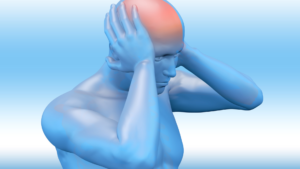Migraines aren’t just a typical headache. Chronic migraines can wreak havoc on a person’s life. If you’ve experienced these extreme episodes, you know they are very painful and can have someone disabled for very long periods of time. Chronic migraines are a very real challenge, but thankfully, some things can be done to treat them.

Chronic Migraine Causes and Treatments
What is a migraine, and what causes it?
A migraine is a type of headache characterized by recurrent attacks of moderate to severe head pain that is often accompanied by nausea, vomiting, and sensitivity to light or sound.
Migraine headaches are believed to be caused by the dilation and contraction of blood vessels around the brain.
Migraines can be caused by factors such as dehydration, stress, or withdrawal from caffeine.
Medical experts are still unsure of the exact causes, but the consensus is a temporary abnormal brain function and misfiring of nerves.
Medical Treatment Options for Severe and Chronic Migraines
The two most common treatments for severe and chronic migraine are Botox and nerve blocks.
Botox is a procedure where injections of purified botulinum toxin are made into the muscle tissue of the forehead to reduce the muscle contractions in this region, which can lead to headaches.
Nerve blocks work by injecting pain medication (such as anesthetic or cortisone) around certain nerves in the neck, head, or face.
Holistic remedies include treatments such as acupuncture and biofeedback.
For more information on medications, remedies, and medical treatments, click here.
What Medicines are Available for treatment?
Anti-seizure medicines, along with beta-blockers and anti-depressants, are all within the realm of choices doctors go to to find treatments for their patient’s pain. Some aren’t advisable for pregnant women, or women who are attempting pregnancy, so keep that in mind!
How can Chronic Migraines be Prevented?
Depending on why they occur, chronic migraines can sometimes be prevented by certain lifestyle changes, such as drinking more water, working out, and eating better. But, sometimes, the causes are more complex than that, and prevention requires medical intervention. Those preventative measures can come in many forms, such as Botox, Calcium blockers, and certain supplements.
One typical supplement used to prevent migraines is magnesium. Magnesium interacts with the chemicals in the brain and can stop a migraine before it happens. For more information on using magnesium to treat chronic migraines, click here.
What will Happen During an Appointment to Find Treatment?
A specialist will sit with you and ask a range of questions surrounding your family history, genetics, and lifestyle. If further testing is needed, an MRI or CT scan may be needed, and then from there, treatment will be decided based on input from yourself and your doctor.
Migraines don’t have to take over your life; you don’t have to wait out the pain. Take control of your pain management and contact Progressive Pain Management to gather more information on how we can help you on your journey to a pain-free life!
Headaches are a common occurrence in adults. So much so that they are the most frequent complaint doctors hear from their patients. Headaches can be truly painful and debilitating from time to time, but are typically treated with over-the-counter NSAIDs or rest. However, in some cases, headaches can become so severe that medical attention is necessary.
It is important to understand the kind of headache you are experiencing and to know when to seek a doctor’s medical help.
The International Classification of Headache Disorders defines over 100 different types of headaches. Some headaches are caused by underlying conditions (secondary headaches) while others are the main medical concern. Those are called primary headaches, and there are three main types of primary headaches that cause people to seek the help of a doctor.

Types of Headaches
Three Most Common Types of Primary Headaches
Tension Headache
Tension headaches are the most common type of headache – 3 out of 4 adults experience this type of headache. Generally, tension headaches cause a dull pain on both sides of their head, sometimes with a squeezing pressure like your head is in a vice. The pain is usually mild-to-moderate, lasting anywhere between 20 minutes and 2 hours.
Stress and muscle tension, as well as genetics and environment are thought to cause these headaches. Fatigue is also thought to play a role.
Tension headaches are typically treated with over-the-counter medications like acetaminophen (Tylenol) or NSAIDs like aspirin (Aleve) or ibuprofen (Motrin). Always follow the directions on the label as misuse could result in severe side effects to your internal organs. If your headache is mild, a snack or short rest may help.
Migraine
Migraines are less common than tension headaches, but the symptoms are much more severe and intense. This throbbing pain is frequently accompanied by nausea, light sensitivity, and lack of appetite.
Women are 2-3 times more likely to suffer from migraines than men. Neurologists believe that migraines are caused by changes of blood flow to the brain and nerve cell activity, with genetics playing a large role. Many people who experience migraines have one or more family member with the same condition.
Migraines often come without warning and is commonly set off by a trigger. These triggers can vary from person to person. Some common triggers are:
- Changes in weather and humidity
- Fatigue
- Emotional stress
- Sensory triggers like flickering lights, strong smells, or loud noises
- Dietary triggers: chocolate, red wine, MSG, change in caffeine intake
Treatment for migraine headaches depends on the severity of your pain and frequency of this type of headache. Most migraines can be dissolved with over-the-counter medication. Although, if they become severe enough and are debilitating, doctors may prescribe medication for immediate relief, as well as a preventative drug to ward off future migraines.
Cluster Headaches
Cluster headaches are uncommon, but cause sudden onset severe pain that is felt behind the eyes. These headaches are much more severe than tension headaches or migraines and last between 1 to 3 hours. The pain may cause your eyes to become red and watery and eyelids may droop. Nausea may accompany the pain.
They are called cluster headaches because they come in clusters: a person can experience 1-8 headaches a day during a 2-month period every year or so. They typically occur at the same time of year with the pain being the same.
Unlike migraines, cluster headaches are 5 times more common in men than women. While there is no direct cause, they are frequently triggered by alcohol or tobacco use, foods that contain nitrates, or bright light. Certain lifestyle changes are recommended to reduce symptoms and the chances of having onset cluster headaches:
- Quitting smoking
- Prednisone; medication to reduce inflammation or swelling
- Diet changes – limiting food that is high in nitrates like lunch meat or bacon
- Limited alcohol
If those changes do not seem to improve your cluster headaches, doctors may prescribe medications such as lidocaine nose drops, verapamil, or sumatriptan. These drugs are often administered by injection.
If you suffer from any type of headache frequently, you should see a doctor. Frequent, constant headaches may be a sign of an underlying medical condition or lifestyle choice. It is important to work with your doctor and communicate your pain levels and symptoms with your physician so an effective treatment plan can be created.
Oops! We could not locate your form.

